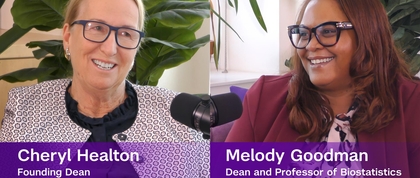From faculty research announcements to campus updates and global public health news, stay up-to-date on the latest from the School of Global Public Health.
News
EP174 Ten Years of Impact with Dean Melody Goodman and Founding Dean Cheryl Healton
November 20, 2025
In this special 10th-anniversary episode, Dean Melody Goodman and Founding Dean Cheryl Healton reflect on the decade-long journey of NYU GPH.
Continue
Dean Melody Goodman and Dr. José Pagán Named NY Power Players in Health Care
November 20, 2025
Dean Melody Goodman and Dr. José Pagán have been named to the PoliticsNY & amNY 2025 Power Players in Health Care list.
Continue
Public Health Changemaker: Shana Moore-Pierre, MA '22, MPH '23 Giving a Voice to Patients as a Medical Ethicist
November 7, 2025
Having earned a bachelor’s degree in biology and philosophy, Shana combined interests in both by enrolling at GPH to pursue an MA in Bioethics.
Continue
Lab Spotlight: Applied Global Public Health Initiative (AGPHI)
November 3, 2025
AGPHI provides consultation to health and development projects around the world in partnership with local leaders, Ministries of Health, WHO, PAHO, UNICEF, and others.
Continue
Elizabeth Gomez on Creating the GPH Marketplace
November 3, 2025
For Elizabeth Gomez, MPH ’25 the path to creating the GPH Marketplace was a culmination of classroom learning, collaboration and real-world problem solving.
Continue
EP173 Unlocking Opportunities in Oral Health Advocacy with Kiran Nagdeo
October 30, 2025
We speak with Kiran Nagdeo, a doctoral student with a background in dentistry. Kiran shares her journey from being a practicing clinician in India to a leader in public health research.
Continue
Lessons in Resilience and Recovery After Natural Disasters
October 29, 2025
GPH hosted a lecture for 2025 NYU Alumni and Families Weekend titled "Lessons in Resilience and Recovery After Natural Disasters"
Continue
Dr. Claudia Passos-Ferreira Delivers TED Talk: Inside the Mind of a Newborn Baby
October 24, 2025
Bioethics Professor Claudia Passos-Ferreira delivered a recent TED Talk entitled “Inside the mind of a newborn baby.”
Continue
EP172 From Anthropology to Advocacy with Katie Lynch
October 16, 2025
We speak with Katie Lynch, a doctoral candidate in Social and Behavioral Sciences, whose work uniquely blends anthropology, public health, and community-based research.
Continue
NYU GPH Participates in 2025 Community Service Day
October 13, 2025
A group of 60 NYU GPH students, faculty and staff came together at locations across New York City for Community Service Day 2025. It was an action-packed day of teamwork and giving back, and the
A group of 60 NYU GPH students, faculty and staff came together at locations across New York City for Community Service Day 2025.
